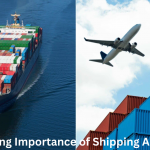Cross-border shipping plays a crucial role in today’s global economy, enabling businesses to sell products across international borders and expand their market reach. With the rise of e-commerce, more businesses than ever are engaging in cross-border trade, delivering goods to customers in different countries. However, cross-border shipping comes with its unique challenges, such as customs regulations, taxes, and higher shipping costs. Despite these obstacles, mastering the process of international shipping can offer tremendous growth opportunities for businesses of all sizes.
In this article, we’ll explore the key aspects of cross-border shipping, the challenges that businesses face, and how to overcome them to take full advantage of the global marketplace.
What is Cross-Border Shipping?
Cross-border shipping refers to the process of shipping goods across international borders. It involves not only the physical movement of products but also compliance with the customs and import/export regulations of the countries involved. Cross-border shipping differs from domestic shipping in several key ways:
- Customs and duties: Import taxes (duties), value-added taxes (VAT), and other fees may be applied when goods cross borders.
- Documentation: Businesses need to provide specific documents, such as commercial invoices and packing lists, to comply with customs regulations.
- Shipping carriers: Different carriers may be better suited for international shipments depending on their service area, speed, and cost structure.
For businesses engaged in global trade, understanding the nuances of cross-border shipping is essential to deliver products efficiently and at a reasonable cost.
The Benefits of Cross-Border Shipping
Expanding into international markets provides several benefits for businesses, including:
- Access to new customers: Cross-border shipping allows businesses to reach new customers in untapped markets. With e-commerce making it easy to connect with consumers worldwide, the potential for sales growth increases significantly.
- Diversification of revenue streams: International sales can help businesses reduce dependency on their domestic market and provide a cushion during local economic downturns.
- Increased brand visibility: By selling internationally, a business gains global brand recognition, helping it stand out from competitors and establish a stronger presence in the global market.
- Higher profit margins: Some markets may be willing to pay more for your products than domestic customers, enabling businesses to achieve higher profit margins.
Despite these advantages, shipping across borders is more complex than domestic deliveries. To succeed, businesses need to navigate a range of challenges effectively.
Challenges of Cross-Border Shipping
While the benefits of cross-border shipping are clear, there are several challenges that businesses must overcome:
1. Customs and Regulatory Compliance
One of the biggest hurdles in cross-border shipping is navigating customs regulations. Each country has its own rules regarding what products can be imported, along with specific documentation requirements. Businesses must also understand:
- Customs duties: These are taxes imposed by governments on imported goods, often based on the value or weight of the item.
- Import restrictions: Certain products may be restricted or prohibited in some countries. For example, items like alcohol, perishables, or technology may face tight regulations.
- HS codes (Harmonized System): These are standardized product classification codes used internationally to identify goods for customs purposes. Incorrectly using HS codes can lead to delays or fines.
To streamline the process, businesses should work with reliable customs brokers or shipping partners who are experienced in handling international shipments.
2. Shipping Costs and Delivery Times
Shipping internationally is typically more expensive than domestic shipping due to factors such as longer distances, different delivery infrastructures, and customs processing fees. Furthermore, customers expect faster delivery times, yet cross-border shipping can lead to longer delays due to customs clearance or distance.
To address these concerns:
- Compare shipping carriers: Different carriers offer varying rates for international shipping, so businesses should compare options based on cost, delivery speed, and reliability.
- Optimize packaging: Shipping costs are often calculated based on dimensional weight (the size and weight of the package), so businesses can save money by using efficient packaging.
- Offer multiple shipping options: Allow customers to choose between cheaper, slower shipping options and more expensive, expedited delivery services.
3. Taxes and Duties
In addition to shipping costs, businesses must account for international taxes and duties. These fees can vary widely depending on the country, product category, and value of the goods. For example, many European countries charge VAT on imported goods, while other regions may have import duties based on the value of the product.
To manage these costs:
- Communicate clearly with customers: Be transparent about who is responsible for taxes and duties—whether the customer will be required to pay them upon delivery or if they are included in the purchase price.
- Use DDP (Delivered Duty Paid) shipping: DDP ensures that all duties and taxes are paid upfront, so customers won’t face unexpected fees upon delivery.
- Understand international tax laws: Work with tax experts or shipping partners who are familiar with the tax regulations of the countries you ship to.
4. Returns and Reverse Logistics
Managing returns for cross-border shipments is much more complicated than for domestic deliveries. The process of returning goods internationally can be costly and time-consuming, involving customs clearance, reverse shipping fees, and restocking.
To make cross-border returns easier:
- Provide clear return policies: Make sure international customers understand the return process, costs, and timelines upfront.
- Offer localized return centers: Consider setting up return centers in key international markets to reduce the cost and time of handling returns.
- Partner with logistics companies: Work with third-party logistics providers (3PLs) that specialize in international returns to streamline the process.
5. Language Barriers and Payment Options
Different languages, currencies, and payment methods can present additional challenges for businesses engaging in cross-border trade. Customers in different regions may prefer specific payment methods (e.g., credit cards, PayPal, bank transfers), and offering localized payment options is crucial to converting international customers.
To improve the cross-border customer experience:
- Localize your website: Consider translating your website into the languages of your target markets and displaying prices in local currencies.
- Offer international payment gateways: Use payment processors that support a wide range of currencies and payment methods to accommodate international customers.
Best Practices for Successful Cross-Border Shipping
To succeed in cross-border shipping, businesses should adopt the following best practices:
- Partner with Experienced Carriers
Work with shipping carriers that have a global reach and expertise in cross-border shipping. Some companies, such as DHL, FedEx, and UPS, specialize in international shipments and offer customs brokerage services to simplify the process. - Streamline Documentation
Ensure that all required documents, such as commercial invoices, packing lists, and certificates of origin, are completed accurately to avoid delays at customs. - Use Shipping Software
Shipping software can help automate the process of selecting carriers, calculating duties and taxes, and generating shipping labels. It also integrates with e-commerce platforms to track shipments in real-time, providing transparency for both businesses and customers. - Offer Transparent Pricing
Be clear with customers about shipping costs, taxes, and delivery times to prevent abandoned carts. Provide estimated delivery dates and give customers the option to choose between various shipping methods based on speed and cost. - Consider Working with a 3PL
Third-party logistics (3PL) providers can handle the complexities of cross-border shipping, from customs clearance to last-mile delivery. They can also offer localized warehousing and returns management, allowing businesses to offer faster and cheaper shipping to international customers.
Conclusion
Cross-border shipping offers enormous opportunities for businesses to expand their reach, increase sales, and build a global brand. While the process comes with its challenges—such as customs regulations, higher shipping costs, and managing international returns—adopting the right strategies and working with experienced partners can make cross-border shipping more manageable.
By simplifying the complexities and providing a seamless customer experience, businesses can successfully tap into the growing global market and drive international growth.
FAQs
1. What is cross-border shipping?
Cross-border shipping refers to the process of shipping goods from one country to another. It involves international shipping logistics, customs clearance, duties, taxes, and regulatory compliance, which differ from domestic shipping.
2. What are customs duties, and how are they calculated?
Customs duties are taxes imposed by a country on imported goods. The duties are typically based on the type of product (HS code), its declared value, and the destination country. Different countries have their own duty rates, and failing to pay duties can result in shipping delays or fines.
3. What are HS codes, and why are they important for international shipping?
HS codes (Harmonized System codes) are internationally recognized product classification codes used to define goods for customs purposes. They are essential because customs authorities use them to apply duties and taxes. Using incorrect HS codes can result in customs delays, fines, or the rejection of your shipment.
4. What is the role of VAT (Value-Added Tax) in cross-border shipping?
VAT is a consumption tax applied to goods and services in many countries. For cross-border shipments, businesses may need to collect and remit VAT based on the destination country’s tax laws. The amount of VAT varies by country and product type. Businesses should ensure compliance by understanding the VAT requirements of their target markets.
5. How do I know if my products are eligible for cross-border shipping?
Before shipping internationally, ensure that your products comply with the import regulations of the destination country. Some products may be restricted or prohibited for import due to safety, health, or environmental concerns. Additionally, certain countries may require specific certifications or labeling requirements for products such as electronics, food, or cosmetics.




